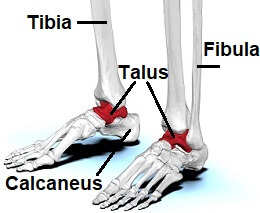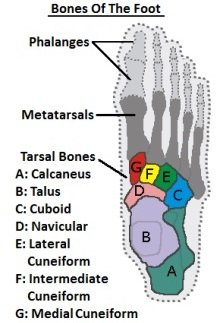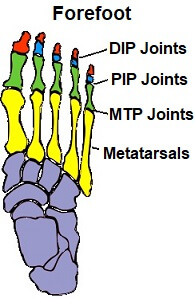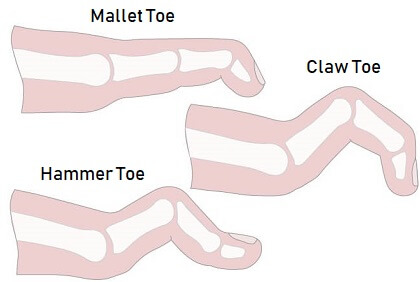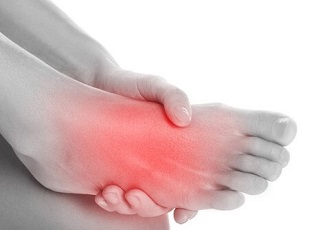- Home
- Anatomy Guide
- Bones
Foot Bones
Written By: Chloe Wilson BSc(Hons) Physiotherapy
Reviewed By: FPE Medical Review Board
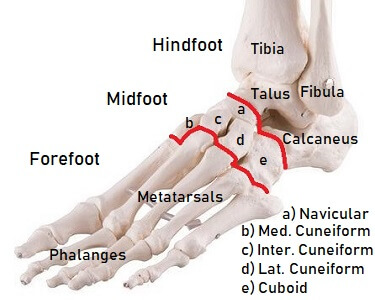
There are thirty three foot bones in humans making the foot and ankle a complex structure.
The bones are arranged to be strong, stable and yet flexible enough for movement.
The foot itself can be divided into three sections: the hindfoot, midfoot and forefoot and the foot bones can be grouped into three sets: the tarsal bones, the metatarsals and the phalanges.
The most common problems affecting the foot and ankle bones are fractures (breaks in the bone), abnormal positioning (e.g. flat feet) and excessive bone growth (e.g. bunions and bone spurs).
Here, you can find out all about the different foot and ankle bones. We will look at how they fit together to provide an efficient way for us to move and what commonly goes wrong with them.
The Hindfoot
The hind foot is the area at the back of the foot, comprising of the two shin bones and two tarsal bones.
There are two joints in the hindfoot, the:
- Ankle Joint: The ankle joint allows the up and down motion of the ankle
- Subtalar Joint: the subtalar joint allows the side to side movement.
The four foot bones in the hindfoot are the:
1. Tibia
The tibia is the long bone at the front of the shin that runs down from the knee. It forms the top and inner side of the ankle joint where it meets the talus bone of the foot.
Towards the bottom of the tibia, the bone expands outwards forming the medial malleolus, the prominent part on the inner side of your ankle.
2. Fibula
The fibula is the smaller shin bone that runs down the outer side of the lower leg. At the bottom it also expands outwards, forming a bony prominence known as the lateral malleolus. It extends slightly lower than the medial malleolus forming the outer side of the ankle joint where it articulates with (meets) the talus.
3. Talus
The talus is the highest foot bone. It forms the bottom of the ankle joint,
articulating with the tibia and fibula (shin bones) and the top of the
subtalar joint, articulating with the calcaneus (heel bone).
Interestingly, no muscles attach to the talus. The talus is held in place by
the foot bones surrounding it and various ligaments.
4. Calcaneus
The calcaneus is more commonly known as the heel bone. It is the largest of the foot bones and has a quadrangular shape. The calcaneus is the most commonly fractured tarsal bone, usually from a high fall. The achilles tendon attaches here linking the calf muscles to the back of the heel.
The Mid Foot Bones
The midfoot is made up of five further tarsal bones. These foot bones sit together to form the main shape of the foot, the foot arches. The bones in the midfoot are the:
1. Navicular
The navicular bone is found on the inner side of the foot. The navicular articulates with five of the other tarsal bones - at the top with the talus, talonavicular joint, laterally (outer side) with the cuboid, cubonavicular joint, and at the bottom it articulates with the three cuneiform bones.
In around 10% of the population, a small extra piece of bone develops next to the navicular which may or may not be attached to it - this is known as an accessory navicular and cause inner arch pain.
2. Cuboid
The cuboid foot bone is found on the outer side of the foot. At the back, it links to the heel bone, known as the calcaneocuboid joint.
On the medial side the cuboid bone articulates with the navicular and third cuneiform on the medial side. At the front it forms the lateral link between the tarsal and metatarsal foot bones, known as the tarsometatarsal joints.
3. Cuneiform Bones
There are three cuneiform bones:
- Medial Cuneiform: on the inner side aka 1st cuneiform,
- Intermediate Cuneiform: in the middle aka 2nd cuneiform
- Lateral Cuneiform: on the outer side aka 3rd cuneiform
The cuneiform bones form the medial tarsometatarsal joints linking the tarsal bones to the metatarsals. They also all link to the navicular posteriorly (at the back) and the lateral cuneiform articulates with the cuboid bone.
The Forefoot Bones
The forefoot is made up of the five long metatarsal bones and the fourteen small toe bones known as the phalanges.
1. Metatarsal Bones
The five metatarsals are the long bones that link the tarsal bones to the toes, seen in yellow in the diagram below. They are numbered from one to five, starting from the medial (inner) side of the foot.
The first metatarsal bone, the shortest, thickest and strongest metatarsal, links to the big toe. The second metatarsal bone is the longest. These foot bones get shorter as you move laterally towards the fifth metatarsal bone which links to the little toe aka pinky toe.
Each metatarsal has a head (closest to the toes), body and base (closest to the ankle). They articulate proximally to the tarsal bones.
The first metatarsal bone links to the medial and intermediate cuneiform, the second metatarsal to all three cuneiforms, the third metatarsal to the lateral cuneiform, the forth metatarsal to the lateral cuneiform and cuboid foot bones and the fifth metatarsal bone to the cuboid.
Stress fractures of the metatarsal bones are often seen in football players,
most notably David Beckham (second metatarsal), Wayne Rooney (fourth
metatarsal), Michael Owen (fifth metatarsal bone) and Kieran Gibbs
(first metatarsal bone). Fifth metatarsal fractures are the most common by far.
2. Phalanges
The phalanges are the small foot bones that make up the toes. The big toe is made up of two phalanges, whilst the other four toes, known as the lesser toes, and each made up of three phalanges:
- Proximal Phalanges: (green on diagram) these are the toe bones that articulate with the metatarsals, at the joints known as the metatarsophalangeal joints (MTP). They tend to be the largest of all the phalanges
- Middle/Intermediate Phalanges: (blue) these are the small phalanges in the middle of the toes. The big toe does not have a middle phalanx
- Distal Phalanges: (red) these are the toe bones furthest away from the body
The joints between the proximal and middle phalanges are known as the proximal interphalangeal joints (PIP) and the joints between the middle and distal phalanges are known as the distal interphalangeal joints (DIP).
Common Problems in the Foot Bones
The most common problems affecting the foot bones are injury and stiffness which can changes the position of the joints:
- Hammer, Mallet, & Claw Toe: These are the most common problems affecting the toe joints. The toe joints get pushed into the wrong position in various ways causing the toes to bend. Each one presents slightly differently.
- Accessory Navicular Syndrome: Irritation of the small extra piece of bone that can form in the inner foot arch
- Turf Toe:This is a common problem in athletes affecting the big toe. It causes pain, inflammation and stiffness
- Bunions: These most commonly affect the big toe, the classic symptom of which is the toe deviating inwards forming a lump on the outer side of the foot
- Fractures: If too much stress is placed through the foot bones, either through a one-off injury, or as a result of repetitive stress, the bones can break
- Bone Spurs: These develop when excess layers of bone are formed in response to repeated friction on the bone.
- Shin Splints: Common in runners who have recently increased their activity levels, there is inflammation of the lining of the tibia bone, resulting in pain and tenderness along the inner, lower shin
You can find out more about how these problems including how they develop and how to treat them by reading the articles – simply click on the links above. Alternatively, visit the foot pain diagnosis section for help working out what is causing your pain.
You may also be interested in the following articles:
- Foot Lumps & Bumps
- Pain On Bottom Of Foot
- Causes Of Foot Swelling
- Common Foot Injuries
- Foot Pain Treatment
Related Articles
Page Last Updated: 19th November, 2024
Next Review Due: 19th November, 2026
